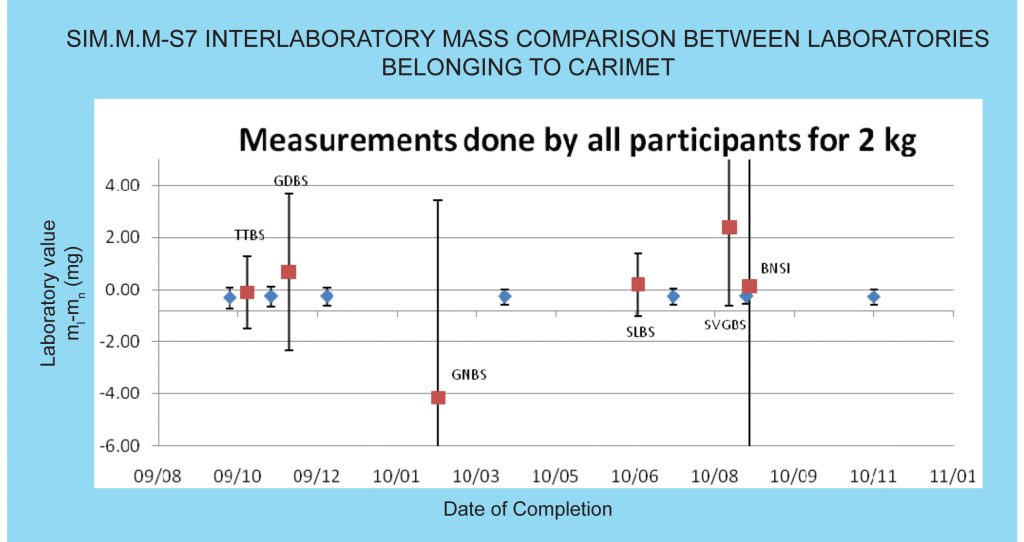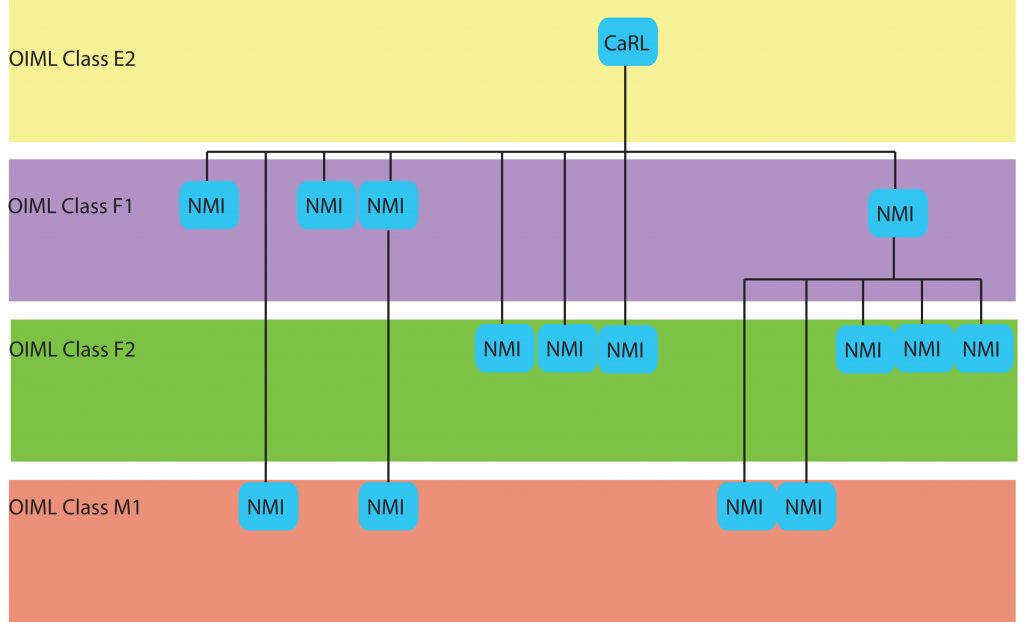Strategies for Developing Metrology in SIDS – The CARICOM Experience
- crosqblog
- on Jan, 10, 2020
- Category Demand for Quality
- Comments Off on Strategies for Developing Metrology in SIDS – The CARICOM Experience
Part 3 of “Developing Metrology In Small Island Developing States”
by David Tomlinson
3. STRATEGIES
Considering the aforementioned challenges, the CARIMET NMIs have taken a position to strengthen metrology by using the following strategies:
3.1 Regional Support Mechanisms
As a response from CARICOM to promote sustainable production and trade of goods and services in the CSME, the CARICOM Regional Organisation for Standards and Quality (CROSQ) was created in February 2002 and given the mandate under Article 67 of the Revised Treaty of Chaguaramas to facilitate the development of regional standards, promote the harmonization of metrology systems and through that, support the sustainable production and trade of goods and services in the CSME. The CROSQ Secretariat is located in Warrens, St. Michael in Barbados and is managed by a Chief Executive Officer (CEO) and governed by a Council made up of the fifteen (15) Directors of the region’s NSBs/NMIs.
3.1.1 The Signing of the International Committee on Weights and Measures Mutual Recognition Agreement (CIPM-MRA) as a Bloc of Nations
As the regional pioneer in establishing an NMI, it was understandable that Jamaica would actively pursue becoming a signatory to the CIPM-MRA and this was done on 21 July 2004. In the following year, on 12 October 2005, CROSQ signed the CIPM-MRA on behalf of the remaining eleven (11) established NMIs. This arrangement as a bloc of nations is unique to CARICOM and affords the Member States the benefit of sharing the financial obligations of being a signatory. Unfortunately, the region has not been able to fully utilise all the benefits afforded as signatories.
3.1.2 Adoption of CARIMET as a Special Committee of CROSQ
The region’s next strategic move to support the development of metrology on a harmonised regional level was the adoption of CARIMET, the Caribbean sub-region of the Inter-American Metrology System (SIM), as a special committee of CROSQ. This was done at the twelfth (12th) meeting of the CROSQ Council held in Bridgetown, Barbados on 9-10 April 2008. Through this mechanism, CARIMET is able to access financial and administrative support from the CROSQ Secretariat. With this development, CARIMET has been able to link the national goals of individual member states within the framework of a harmonised regional metrology system, utilising SIM as the link to the international metrology system.
Using its position as an inter-governmental organisation representing the region, CROSQ has been able to leverage regional and donor funds to make interventions aimed at developing metrology as the region, expanded out of a heavy standardisation focus. In order to access funding and technical assistance, CROSQ formed strategic relationships with such regional institutions as the Caribbean Development Bank (CDB) and the Inter- American Development Bank (IDB) and international institutions such as the German NMI PTB and the European Union (EU). These relationships, however, have not solely been for accessing donor funding but have also allowed CROSQ to use regional metrology expertise to guide bilateral interventions being implemented by these development partners.
3.1.3 Creation of the Position of Technical Officer of Metrology
To assist in coordinating the metrology development activities of CROSQ and the harmonisation of metrology processes in the region’s NMIs, the CROSQ Secretariat created the position of Technical Officer – Metrology and hired a regional expert to fill this position in 2010. In addition to undertaking tasks assigned by the CEO of the CROSQ Secretariat, this technical officer serves as a technical resource for the Member States providing them with guidance on technical topics or identifying suitable experts and resources that can assist with their national development plans. The officer also serves as the Technical Secretary of CARIMET and is responsible for monitoring the progress of CARIMET activities, reporting on these activities to the CROSQ Council and providing the CARIMET Coordinator with administrative support as required.
3.1.4 Cooperation with the Dominican Republic
On 22 August 1998, the Dominican Republic and CARICOM signed an agreement establishing a free trade area between the two parties. Seven years later, the Dominican Republic took action to strengthen this relationship by applying to become the 16th member of CARICOM. Although the Dominican Republic is not yet a member of CARICOM, the process of regional integration has continued within the framework of the Caribbean Forum (CARIFORUM) of the African, Caribbean and Pacific States (ACP). As a result, CROSQ began to collaborate with the Dominican Directorate General of Standards and Quality Systems (DIGENOR), which has since been replaced with the Dominican Institute for Quality (INDOCAL).
This collaboration started with cooperation in the German Federal Government-funded projects administered by the PTB and grew into INDOCAL being regular invitees to attend the Meeting of the CROSQ Council. From 2011 to 2017, CROSQ, INDOCAL and PTB partnered to develop the 10th European Development Fund Caribbean Regional Indicative Programme (EDF-CRIP) Economic Partnership Programme Technical Barriers to Trade (EPA-TBT) Project which was jointly implemented by all three parties. The three partners are now implementing the TBT Component of the 11th EDF EPA Programme which began in September 2019 and ends in February 2024.
In metrology, INDOCAL cooperates with CROSQ by actively participating in CARIMET. This has included assisting in shaping the CARIMET Strategic Plan for 2016-2020, participating in capacity building activities, hosting regional and international metrology fora and offering to host the Caribbean Reference Laboratory (CaRL) for Electrical Power Measurements. A system of reciprocating administrative support and mutual respect has fostered strong professional ties between CROSQ and INDOCAL.
3.1.5 Increased Participation in SIM
For many years, SIM has been and continues to be an important ally in the development of metrology in CARICOM, not only because of the many training initiatives that are executed by SIM but also because of the atmosphere of comradery and technical assistance that permeates the organisation. Through SIM, CARIMET NMIs have benefited from bilateral assistance rendered from other NMIs.
CARIMET NMIs have relied on funding from the Organisation of American States (OAS) administered through SIM to support their participation in SIM activities. However, as funding from the OAS decreased so did CARIMET participation. As CARIMET implements its strategic plan for 2016-2020 (see 3.1.6), SIM’s role will be even more important than before. This plan includes more active representation at the SIM Quality Systems Task Force (QSTF) and MWGs and increasing the number of submissions from CARIMET NMIs to the SIM-QSTF. As a result, additional funding must be allocated from national and regional initiatives to ensure the increased participation of CARICOM NMIs in SIM.
Seeing this need, the 10th EDF-CRIP EPA-TBT Project was conceptualised to use CARIMET as the Technical Implementation Group (TIG) for the metrology component. In return for CARIMET’s assistance in planning the annual operating plan for the project, the project partially supports NMIs’ attendance at the SIM General Assembly and other MWG activities that are considered to be of regional importance. In recent years this partial funding has been graciously met with counterpart funding from the American National Institute of Standards and Technology (NIST) for the SIM General Assembly and SIM counterpart funding for CARIMET NMIs’ participation in the MWG meetings and training interventions.
3.1.6 CARIMET Strategic Plan 2016-2020
In 2010, CARIMET recognised the need for a structured approach to the regional development of metrology which led to the creation of the first CARIMET Strategic Plan in Frigate Bay, Saint Kitts & Nevis in 2011. With the expiration of this first plan in 2015, CARIMET took the lessons learned from this plan to develop a more pragmatic plan for 2016-2020. Using this 2016-2020 Strategic Plan CARIMET hopes to bring the benefits of metrology into the mainstream of Caribbean industry and society.
3.2 Development of Regional Metrologists
Over the years, CARIMET has pursued various options to develop the competence of the region’s metrologists. Many have benefited from training interventions organised by CROSQ or by Regional Metrology Organisations (RMOs) such as SIM and EURAMET. In addition to bilateral assistance within SIM, there has been regional training provided by other more developed NMIs such as the German National Metrology Institute (PTB), the Mexican National Metrology Centre (CENAM), the Brazilian National Institute of Metrology, Quality and Technology (INMETRO), the Argentinian National Institute of Industrial Technology (INTI), the Peruvian National Metrology Service of the National Institute for the Defense of Competition and Protection of Intellectual Property (SNM-INDECOPI) and the American National Institute for Standards and Technology (NIST).
As the regional competence in metrology is improved by external interventions there has been an increase in the number of capacity building activities planned and implemented within CARIMET. In addition to planning workshops on topics of regional interest, there has been an increase in the number of NMIs sending their experts to train other NMIs and also, the attachment of metrologists within CARIMET NMIs.
3.2.1 CARIMET Capacity Building Programme in Metrology
Metrology is a multifaceted science starting from the scientific theory and research that forms the basis for the realisation of measurements, to the application of these measurement standards to real-world situations, the maintenance of adequate laboratory facilities and equipment, the statistical calculations that are required to instil confidence in the quality of the measurement taken and all the records and documentation that must be created and maintained. Appropriately then, the development of competence in metrology requires a varied approached to knowledge transfer. As a result, the CARIMET Capacity Building Programme in Metrology was conceptualised to combine workshops, work attachments and short term consultancies with the aim of stimulating the most professional growth within the shortest possible time.
The first cohort of this programme was made up of three (3) groups of experts who were simultaneously developed as a cadre of regional experts in three (3) areas. In the first instance, the areas of Mass Metrology, Thermometry and Volumetry will be developed within a period of one (1) year. Fifteen (15) metrologists will be selected from all CARIFORUM States, through a competitive application process to form three (3) groups of five (5) metrologists each focusing on one area.
3.2.2 Inter-Laboratory Comparisons
Inter-Laboratory Comparisons are important tools in demonstrating the equivalence and competence of measurement capabilities of different NMIs. By comparing their results with other NMIs, this allows the laboratories to identify any deficiencies or areas for improvement, after which they can take the required action. For the metrologist, this is also important for demonstrating his/her competence in comparison with his/her peers and can be an important learning and confidence-building tool. This demonstration of the technical and professional competences of metrologists is critical for their development to the point of being considered “experts” in their respective areas of focus. Within CARIMET, the largest two (2) NMIs, the Bureau of Standards Jamaica (BSJ) and the Trinidad & Tobago Bureau of Standards (TTBS) have been actively participating in comparisons planned by SIM and other RMOs in areas of national importance. CARIMET, knowing the value of these comparisons and recognising the need for other CARIMET NMIs to participate in comparisons, began to plan its own.
The first CARIMET comparison, SIM-M.M-S7: Interlaboratory Mass Comparison between Laboratories Belonging to CARIMET [4] was conducted between 2009 and 2010 and involved seven (7) CARIMET NMIs. For five (5) of these NMIs, it was their first time participating in a comparison published on the International Bureau of Weights and Measures (BIPM) Key Comparison Database (KCDB). The pilot laboratory was the BSJ and since this was the bureau’s first time in this role, the then Chair of the SIM Mass & Related Quantities Working Group (MWG 7), Mr. Francisco Garcia of Chile’s Centre of Measurement Studies and Quality Certification (CESMEC), served as coach.
The second CARIMET comparison that is now being implemented is the CARIMET Comparison at 20 Litre Volume. This comparison has a total of nine (9) CARIMET NMIs and CENAM will be providing the link to the BIPM KCDB. Additionally, invitations have been extended to the Kenya Bureau of Standards (KEBS) and the Cuban National Research Institute of Metrology (INIMET). The BSJ is also the pilot laboratory for this comparison and is being coached by Dr. Roberto Arias of CENAM.

3.3 Regional Cooperation Schemes
The individual markets of most Caribbean countries are too small to sustain all the calibration services required to support trade. As a result, private investors have no interest in establishing calibration laboratories in many of these islands, leaving the manufacturing sector looking to the Government for support. In order to ease the burden on individual states and assist in accelerating their access to metrology services, two (2) regional cooperation schemes have been conceptualised and are now being implemented.
3.3.1 Caribbean Reference Laboratory (CaRL) Scheme
In order to ensure the traceability of their national reference standards to the International System of Units (SI), each CARICOM NMI would independently try to identify the most cost-effective calibration service provider. This could either be another NMI or a private calibration laboratory. In an attempt to ensure that the national reference standards in all NMIs are calibrated by another NMI and at the same time reduce the cost of these high-level calibrations, the concept of the Caribbean Reference Laboratory (CaRL) was developed in 2010.
A Caribbean Reference Laboratory (CaRL), is a metrology laboratory within a National Metrology Institute (NMI) or Designated Institute (DI) in CARIMET, recognized by the CROSQ Council as a regional reference laboratory providing traceability for a measurement quantity within a defined scope. This capability must be demonstrated by either internationally recognized accreditation and/or the publication of the laboratory’s Calibration and Measurement Capabilities (CMCs) on the BIPM KCDB.
The development of a CaRL first starts with the identification of an area of demand based on the requests for support from all the NMIs in CARICOM. Once a metrology quantity is identified as requiring a CaRL, expressions of interest are then made to CARIMET from those who have the capability or potential to serve as the CaRL for this measurement quantity. An NMI is then selected by CARIMET for development and ratified by the CROSQ Council based on the technical competence of the metrologists working in the laboratory, the level of development of their existing service, and the sustainability of that service based on that NMI’s own national demand. Regional funds are then allocated to complement the national development plans for this laboratory. After receiving international recognition for their measurement capability, the laboratory would then be officially recognised as a CaRL by the signing of a Memorandum of Understanding (MOU) between the parent NMI and the CROSQ Council.
If we treated the unified CARICOM region as one nation then in this model, the CaRL would be operating as the NMI for the region. This would, therefore, allow each NMI to operate as a national calibration laboratory and focus on fulfilling only the sustainable demand within their country. Any demand outside of this scope could then be cared for directly by the CaRL. On 1 February 2013, the Mass Laboratory of the BSJ was recognised as the region’s first CaRL. This was to provide mass calibrations for the range 1mg to 20kg according to OIML Class E2. Since that time the BSJ has been having challenges with the environmental climate control in the laboratory and the scope has been downgraded to OIML Class F1. However, the BSJ has taken corrective action and with a national project funded by the World Bank is now accredited by the German Accreditation Service (DAkks) to provide mass calibrations up to OIML Class E2.

Two (2) more CaRLs have since been developed – the Volume CaRL at the BSJ and the Temperature CaRL at the Trinidad & Tobago Bureau of Standards (TTBS). There are plans for the development of three (3) more CaRLs in the short- to medium-term. The Volume and Temperature CaRLs were developed with funding from the 10th EDF-CRIP EPA-TBT Project. Technical Assistance for the development of these two (2) CaRLs was kindly provided by fellow SIM NMIs. The SNM–INDECOPI provided their thermometry expert; Mr. Edwin Guillen to guide the TTBS in the development of the Thermometry CaRL and NIST provided Dr. John Wright as a resource for the Volumetry CaRL at the BSJ.
The development of a CaRL for Electrical Power Measurements at INDOCAL and the Pressure and Humidity CaRLs at the TTBS are in the early planning phases.
3.3.2 Mobile Calibration Service
The first indication of the need for a regional mobile calibration service was that most CARIMET NMIs own a large number of 20kg and higher weights procured using their own national funds or through support from development partners. For example in 2012, twenty (20) 20kg weights along with two (2) 50kg weight baskets totalling 500kg were delivered to the CARIMET NMIs through support from the German Government-funded project entitled, “Establishment of a demand-oriented and regionally harmonized quality infrastructure in the Caribbean”, which was being implemented by PTB. In addition to these 20kg and 50kg weights, most NMIs already owned a number of metric and, in some cases, imperial weights. These weights all require regular calibration in order to maintain their traceability to the SI. Without this traceability, the use of these weights is almost pointless as there is no documented means of proving the acceptability of the values. In many cases, these weights go uncalibrated due to the undeveloped national mass metrology service and the economic infeasibility of shipping a large number of 20kg weights to Jamaica, Trinidad & Tobago or elsewhere for calibration.
In an attempt to ensure the traceability of these weights, a mobile calibration service for 20kg and 50 kg masses up to OIML Class M1 will be developed at the Saint Lucia Bureau of Standards (SLBS). This service will have international recognition through either accreditation from a recognised Accreditation Body or through the CMCs being published on the BIPM KCDB. The preferred route will be to utilise the systems within SIM to support the publishing of CMCs.
Two (2) mass metrologists from the SLBS, who fulfil pre-established criteria, will be further trained in the performance of this service. It will be preferable to support this infrastructure with training attachments from other NMIs in due course. These technicians must already possess a strong competence in handling mass metrology weights and equipment and must be available to travel to other regional NMIs to conduct the calibrations.
In addition to this mass metrology service, other calibration services will be developed as a regional need is identified.
3.4 Technical Assistance with Laboratory Climate Control Specifications
In order to establish the required laboratories within CARIMET NMIs, it will be necessary to either construct new buildings or retrofit the existing buildings. To support all NMIs with this process, technical assistance is being provided through CROSQ to NMIs that are now being built or retrofitted. The lessons learned, specifications developed and contacts made in assisting these NMIs would then be compiled and made available to all the other NMIs.
3.5 Engagement of Regional Customs Agencies and Airlines
In an attempt to ensure the safe transportation of national standards sent overseas for calibration, CROSQ has made direct representation on behalf of CARIMET to both major regional airlines and also to the grouping of CARICOM Customs Agencies. Although the two previously mentioned incidents of damage were experienced when the artefacts were outside of the region, the representation to the Customs Agencies was only a formal action meant to reinforce the delicate nature of the national standards. However, there is already a strong relationship that exists throughout the region between each Customs Agency and their respective NSB/NMI and the risk of damage at this stage is low.
As the CaRL and other regional work-sharing schemes grow, and as the number of CARIMET comparisons increases, it is anticipated that there will be an increase in the number of measurement artefacts that need to be transported within the region. In order to reduce the need for artefacts to be transhipped through the United States, CARIMET has decided that it will use the cargo services of both regional airlines as much as is possible to transport measurement artefacts. The intention behind the representation made to both major airlines was to educate them on the sensitive nature of the measurement artefacts and the importance of their safe transportation. This system has since been tested with one (1) of the airlines and there has been positive feedback from the three (3) NMIs who safely received artefacts.
In an attempt to address the issues outside the region, the CROSQ Secretariat sought guidance from NIST as to the methods they use to ensure the safe transportation of their artefacts. With guidance from the NIST Shipping Department, each CARIMET NMI was provided with a list of recommendations, including a list of preferred couriers, that are utilised by NIST. By implementing these recommendations, it is envisaged that the incidents of damage will be reduced.
3.6 Development of Regional Marketing and Communications Strategy and Action Plan.
With the national perception that the CARICOM NMIs are a standards-setting regulator with the power to detain products and shut down manufacturers, it is has been difficult to accurately determine the true needs of the manufacturing sector and makes it challenging for the NMIs to develop sustainable calibration services.
To assist in changing this perception, a regional Marketing and Communications Strategy and Action Plan [5] was developed by the Marketing, Information, Knowledge and Education (MIKE) Committee of the CROSQ Council. This plan entails two (2) fundamental strategies, the first one being a direct engagement of the national stakeholders by assigning at least one (1) dedicated person to the building and maintaining of the relationship between each stakeholder group. This person would also be responsible for building outreach to these groups in order to gain consensus, support and agreement on interventions being planned. Critical to this strategy’s success is a structured stakeholder management system. The second strategy is a mass communication strategy focused at the end-users of metrology services, geared towards repositioning the CROSQ and national NMI brands in a favourable light. The effectiveness of this strategy hinges on the NMI’s ability to clearly connect real market needs with impactful metrology solutions combined with appropriate messaging and branding.
3.7 Collection of Demand Data
In order to ensure the sustainable development of metrology services, it is critical that each NMI understands the demand for its services. Since most CARIMET NMIs had no data on the actual calibrations needs in their respective country, there must be a concerted effort on their part to collate this data. Although it was possible from the beginning to gather this information using an external consultant, it was thought that since this would have to be an activity that must be periodically repeated it would be best if it was undertaken at a national level by the NMI. In an attempt to stimulate the collection of this data the 10th EDF-CRIP EPA-TBT project began the procurement of equipment for those Member States who had completed and submitted this data to the CROSQ Secretariat. Through this process, in combination with some assistance for a few Member States where resources were particularly low, the Project was able to get an understanding of the demand in all CARICOM countries.
4. LESSONS LEARNED
The following are the major lessons learned over the last five (5) years of developing a regional metrology system:
- The strength of the regional metrology system is national capabilities.
- Regional activities must be developed in such a way that they are not perceived by the NMIs as additional work, but as beneficial steps leading to the success of national development plans.
- An inclusive approach at the planning stage, regardless of the NMIs’ level of development, creates greater buy-in and is educational for the lesser developed NMIs.
- The management of strong relationships at all levels within the NMIs is critical to the success of regional cooperation.
- The administration of all benefits must have clear criteria and a transparent process.
5. CONCLUSION
Notwithstanding the fact that the global metrology community has over a century of history in the development of NMIs with empirical data demonstrating the contribution of metrology to economic and social sustainable development, the development of metrology in CARICOM SIDS continues to prove challenging to individual Member States, and as a result, a regional approach has been developed. This plan has at its core the identification of the demand for calibration services in each country and then developing sustainable calibration services in each country and using regional mechanisms to meet those needs that cannot be met nationally. In the case of CARICOM, the following summary of challenges and strategies to overcome these challenges can be made:
1) The Socio-political environment which places metrology low in the order of priorities at both a governmental and consumer level is being addressed by developing regional support mechanisms. These have included signing the CIPM-MRA as a bloc of nations, the adoption of CARIMET as the metrology special committee of the CROSQ Council, the creation of the regional position of Technical Officer – Metrology to coordinate the regional development of metrology and the increased participation in SIM.
2) The development and management of metrologists in the region are being addressed by the implementation of regional capacity building initiatives to ensure that a pool of skilled professionals is available for the region. Additionally, inter-laboratory comparisons are being used to strategically build competence and confidence and also to demonstrate the technical capability of CARIMET.
3) Developing sustainable calibration services has proved to be a challenge to many countries due to the limited number of industrial clients in individual countries. As a result, NMIs are being developed to address those demands that are sustainable and to complement this, CARIMET is developing regional resource sharing and cooperation schemes. These schemes are the Caribbean Reference Laboratory (CaRL), which establishes a cost-effective entry point for traceability into the CARICOM region, and the mobile calibration services that will enable one (1) NMI to perform calibrations throughout the region on behalf of the home NMI, where an internationally-recognised service is not available.
4) The detached geographical nature of SIDS presents more transportation challenges than countries that share a land border. In the case of CARICOM, there is a weak regional transportation infrastructure and this has made the calibration costs for national standards higher and also increases the risk of damage to these standards (measurement artefacts). As a result, it has been important to ensure that the standards that are being shipped from one CARIMET NMI to another do not have to be transhipped outside of the CARICOM SIDS. To assist in this endeavour the two (2) major regional airlines have been directly engaged as the preferred means of shipping artefacts and the Customs Agencies have been engaged to ensure measurement artefacts are not damaged during inspection.
5) To address the negative image of the NMI as a regulator intent on closing down manufacturers, the region has developed a regional Marketing and Communications Strategy and Action Plan to guide the Member States. 6) The culture inherited from being a part of the public service can only be corrected by directly engaging the stakeholders at a national level. As a result, considerable effort has been placed on encouraging each NMI to engage the manufacturers in order to determine the true needs and to continuously repeat this process.
References
[4] Mitchell, T., Reddock, T., Melville, E., Medford, R., Gittens, A., Miller, J., Rhynd, H. (2013) Interlaboratory Mass Comparison Between Laboratories Belonging To CARIMET, SIM.M.M-S7. Metrologia, 50 (07016)
[5] CROSQ Marketing and Communications Strategy and Action Plan. Chase, R. 2014
*This article was first published in “InfoSIM” (page 5) in September 2016 and updated for this blog in January 2020.




